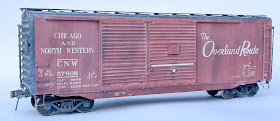The model features some liberal use of etched metal for various details. I can't say that I have fully reached a happy medium of where and when to use etchings, but I suspect that after the forthcoming Milwaukee single sheathed auto car kits, I will have a pretty solid sense of what works and what does not. The photos above illustrate some of that usage. I am quite happy with the underframe. The diagonal braces are a little fiddly to assemble, but I think they are quite good (although the actual arrangement is my best estimation from only a single general arrangement drawing of the car) and the rest of the underframe exceeded my expectations. In particular, the etching of parts to make the brake lever clevises came out better than I expected. This feature will be used on all future kits. I am also mostly happy with the latitudinal running board supports, the grabs, and the brake staff pivot at the bottom of the end. I believe the etchings really accentuate the model and achieve a level of fidelity I could not with other materials.
One other detail that turned out extremely well is the roof. The prototype used the Murphy Solidsteel roof with fairly delicate seam caps where the panels were joined and flat panel sections (if you're not familiar with this style of roof, think of a Murphy rectangular panel roof without the raised, rectangular corrugations in the panels.) The master for this kit is based upon a 3D printed part. The roof is the expert work of Ryan Mendell of National Scale Car. This model would not be possible without his contribution. The results are great. Many thanks!
On to the finishing of the model. I am a strong proponent of blasting metal and engineering plastic parts prior to painting in order to ensure good paint adhesion. I blasted this model with 600-grit aluminum oxide (source for the powder in the link) followed by washing with a soft toothbrush and liquid dishwashing detergent. I primed the model with Badger's grey Stynylres primer. I followed that with Star Brands STR-30 SP/UP Freight Car Red, thinned with their private label thinner, except on the trucks and wheelsets which were sprayed with Tamiya flat black. I then applied a coat of Quick Shine floor polish to ensure a gloss coat for the application of the decals. All three of these were applied with an airbrush. I applied the decals, including a few chalkmarks, and sealed them with another coat of Quick Shine followed by a coat of Tamiya clear flat. I did leave off the reweigh, repack, and brake test stencils and then masked those areas prior to weathering so that those would appear to be freshly painted patches.
 |
| Not the greatest image, but this is a "FRAGILE FREIGHT" placard that I had printed on a sheet run by PDC. It is an actual image of a Milwaukee Road placard |
For weathering, I brushed on two washes of extremely diluted artists' oils with odorless mineral spirits. The first was Titanium White and the second was a blend of Burnt Sienna and Raw Umber. I sealed these with another flat coat, except this coat was Mr. Color clear flat as I had run out of Tamiya (I used Mr. Color Leveling Thinner... note that these are solvent-based as opposed to the Tamiya, which seems to be an alcohol-based acrylic.) I next applied PanPastels Raw Umber and Payne's Grey Extra Dark, mostly in streaks to the sides and overall on the roof, underframe, and trucks/wheelsets. I sealed these with another coat of flat, except on the sides, where I applied Quick Shine, since I needed to add the reweigh, repack, brake test, and chalkmarks, as well as the placard and route car board decals. After adding these decals, I sealed everything with a clear flat coat. I added the trucks and couplers and the finished result is as you see herein. I am extremely happy to have a model of this unusual prototype.
 |
| The decal on the route card board (with the '12') is from the Owl Mountain Models "Route & Grade Card Goodies" decal (#1220) |
Why the relatively long hiatus from posting? I received a summons for jury duty and showed up at the appointed time and place in late October. I fully expected the usual few hours of waiting followed by a dismissal after my services were found to be unneeded. However, over the next few days, I went through the process of jury selection, at which time I was seated as Juror #5 in a murder trial. The trial concluded last week. As you can imagine, it was a major commitment of time, but was also a hugely impactful emotional experience. I am glad to have done it, but I also do not wish to ever do it again. When abstract becomes reality, you quickly discover that determining the fate of another person is not nearly as easy as portrayed in film and television. Onward...














.jpg)







































